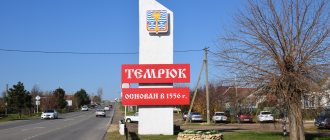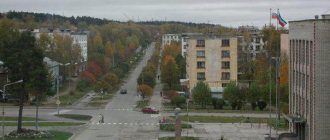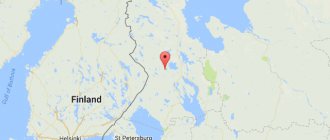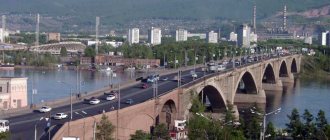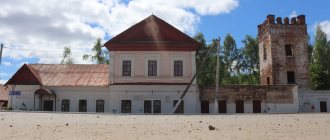Share
Tell
Share
Tweet
Share
“Guberniya Daily” continues the new project “What to do here?”, within the framework of which Evgenia Volunkova and photographer Andrei Myagkov spend weekends in cities and large settlements of our republic. We want to understand how people relax where there seems to be nothing to do. Cafes, discos, parks, clubs, cinemas and libraries. Suoyarvi, Lahdenpohja, Segezha and Pudozh - we will visit everywhere and tell you everything. After Kondopoga, our destination was the city of Segezha.
Brief information
Segezha is located in the central part of Karelia, two hundred and seventy kilometers from Petrozavodsk. The population is about thirty thousand people. The main street is Sovetov Boulevard. A bridge over the railway tracks divides the city into two parts - the Old Town and the Microdistrict. The old town is beautiful, with many cultural sites. And the Microdistrict is like a microdistrict. The heart of the city is the Segezha Pulp and Paper Mill, which is still in relatively good health.
References
Notes
- ^ a b c d f
Law No. 871-RZK - ^ a b
Federal State Statistics Service of Russia (2011).
“All-Russian Population Census 2010. Volume 1" [All-Russian Population Census 2010, vol. 1]. All-Russian Population Census 2010 [All-Russian Population Census 2010]
(in Russian). Federal State Statistics Service. - "26. The size of the permanent population of the Russian Federation by municipalities as of January 1, 2022.” Federal State Statistics Service. Retrieved January 23, 2022.
- ^ a b c d
Law No. 813-RZK - Law No. 825-ZRK
- "On the calculation of time." Official Internet portal of legal information
(in Russian). June 3, 2011. Retrieved January 19, 2022. - Post office. Information and computing center of OASU RPO. ( Post office
).
Search for postal facilities ( Search for postal facilities
) (in Russian) - Federal State Statistics Service of Russia (May 21, 2004). “The population of Russia, the constituent entities of the Russian Federation as part of federal districts, urban settlements, urban settlements, settlements, settlements of 3 thousand or more people.” [Population of Russia, its federal districts, federal subjects, districts, urban settlements, rural settlements - administrative centers, rural settlements with a population of more than 3000 people] (XLS). All-Russian Population Census of 2002 [All-Russian Population Census of 2002]
(in Russian). - “All-Union Population Census of 1989. The current population of union and autonomous republics, autonomous regions and districts, territories, regions, urban settlements and rural district centers” [All-Union Population Census of 1989: current population of union and autonomous republics, autonomous regions and districts, territories, regions, districts, urban settlements and villages performing the functions of district administrative centers]. All-Union Population Census of 1989 [All-Union Population Census of 1989]
(in Russian).
Institute of Demography of the National Research University: Higher School of Economics [Institute of Demography of the National Research University: Higher School of Economics]. 1989 - via Demoscope weekly
. - https://www.gulagmuseum.org/showObject.do?object=61918&language=2
- https://www.cbc.ca/news/world/russia-s-mikhail-khodorkovsky-released-flies-to-berlin-1.2471287
- Ildar Dadin: mortal torture in a Karelian prison Independent Barents Observer AS, 2016
Walks
— In my childhood, Segezha was still a city of “boy clans”: districts and even courtyards were hostile against each other. If you accidentally wandered into someone else’s territory, you could easily get a scoreboard,” recalls former Segezha resident Andrei A. “In our yard on the street. Spiridonov, for example, had his own clan. There was a rocking chair in the yard, everyone went there, so they were afraid of us. It was scary to walk into the Old Town in the evening along the paths across the railway tracks. A gang of “redheads” was on duty in the area - red-haired brothers who took money. If you get caught by the “saffron milk cap,” you’re considered lost. Shakes out money and kicks. If you resist, they will beat you.
Another resident of Segezha, Alexey P., also talks about the clans.
“I remember we always developed a whole plan for how to get past the “saffron milk caps”... One evening, we were sneaking back home. There wasn't a lot of money, but it was still a pity. We had almost crossed the bridge when we ran into some boys. I shouted: “Dvorami! We’re leaving through the yards!” and we ran as fast as I’ve ever run. Then they left. And my friends then saw me for a long time and mocked me, shouting: “We’re leaving through the yards!”
Now there are no more clans. In Segezha, even on weekends it is quiet and, it seems, calm.
Once upon a time in Segezha, in the Old Town, there was a notable Park of Culture and Leisure. It could boast a cool, by Karelian standards, “roller coaster” and many other attractions. The whole city, young and old, came here for a walk. Have fun on the carousel, eat ice cream, read a book on a bench... Today all that remains of the park is a children's slide in the shape of an elephant and two yellow giraffes between trees of unknown purpose. The benches are dilapidated, the bushes are overgrown. The only surviving sculpture of a moose cow with a calf at the back is decorated with white zebra stripes. And yet some continue to go to the park. Out of habit or simply because there is nowhere else to go. Someone drinks beer on a bench behind the bushes, hiding away from prying eyes, someone just sits and thinks about something.
Not far from the park, opposite the cinema, there is a good playground. Nearby, despite the bad roads, children rollerblade and ride bicycles. By the way, about the roads. Our guide, Segezhan Artem, told how one day the mayor came out to people and offered to chip in to repair a very bad part of the road. “There is no money,” the mayor admitted. “Let’s do it ourselves!” And people chipped in.
Today, a good place for walking is “lesokulturka” - a forested park area behind the city sports complex. In winter you can ski there, and in summer you can run, walk and feed squirrels. In Soviet times there was even a large swing boat.
People also walk along the green Katanandova Alley. In the center there is a fountain with benches where you can sit. It's just a pity that the fountain doesn't work. Like no other in Segezha.
Segezhan residents also like to hang out near the new station, the architecture of which stands out from the general background. By the way, at the station there is a free toilet, even if the doors don’t close. We saw another toilet, not far from the station, on the main street. For some reason, the booth is located behind a mesh metal fence.
“This is where the janitors store their shovels,” Artem wasn’t joking.
Eat and drink
Despite the fact that Segezha residents say that they eat exclusively at home, in my opinion, there are enough places to eat in little Segezha.
Directly opposite the station, in a two-story building that used to be a fish store, there is now a new Panarama bar. When asked why “Panarama” is spelled with an “a,” the waiter explained that they once made a mistake and did not correct it, turning it into a “trick.”
“Panaram” is cozy and has a good view from the window. The menu is varied: from beer and pizza to puree soups and even rolls. About the “panoramic” rolls, local resident Alexey said that he was afraid to eat them - “it’s not clear who rolls them there.” Prices are equal to the capital's average, but they don't bite. We tried the Margherita pizza - it was quite good.
Another place where you can have lunch is the Vyg cafe-bar in the Old Town on Grazhdanskaya Street. Segezhan residents say that the interior there is very nice and the food is delicious. We didn’t go to “Vyg”, but we did look into “Bear’s Corner”. This is a recently opened bar in the Segezha hotel complex on the outskirts of the city. The interior is in the Karelian style, there is a stuffed bear in the corner, and ducks on the ceiling. Lunches, dinners and alcohol - everything is here.
Right there in the complex there is a cafe “Segezha”. You can dine here during the day and dance here at night.
Recently, Sushi City opened in the Microdistrict, on the main street. “There,” said Alexey, “you can eat sushi: the Koreans stand and spin it.” You can buy it to take with you, or you can eat it right there. Prices are the same as in Petrozavodsk.
But the confectionery “Irya”, where Andrei A. ran to get delicious eclairs as a child and where we also headed in the hope of enjoying it, no longer exists. And also, according to our guide Artem, there was a place called “Metso” where they fed very well. Now there's a pharmacy there.
In Segezha one thing is very easily and quickly replaced by another. There was a city bathhouse - it became the Bank of Moscow, and more recently - VTB-24. There was a children's clinic - now a Dixie store, and instead of the Children's World, which half the city once went to, there is now a furniture store.
There are also several kebab shops in the city. One of them is on the road to the Culture Park. And shops that sell pies. For example, opposite the House of Culture, in the square there is a large selection of flour products and there are even a couple of tables to sit and eat. According to Alexey, canteens are popular: the recently opened “People’s Canteen” and those located on the territory of the Segezha Pulp and Paper Mill and LDK.
Roads and drinking houses
According to the results of a study on the quality of life conducted by the Segezha Group together with Petrozavodsk State University, 37.4 percent of Segezha residents noted bad roads as the main city problem. Therefore, today, as part of a charity program, the company also helps with the repair of the main roads of the city.
During September and October, major repairs were made on Antikainen, Solunin and Spiridonov streets. The total area of work on milling and laying asphalt pavement on sections of three roads amounted to 20 thousand square meters. Within the perimeter of these streets, 35 exits to courtyards and inter-block driveways have also been restored. City residents actively monitored the progress of the work, and some experts circulated online assessments of “allowed violations of technology during the execution of work.”
Photo: Segezha Group program
To dispel the myths, Segezha Group turned to the supervisory authority. An independent construction laboratory carried out sampling at five locations. Research has shown that the selected asphalt concrete samples meet the requirements of GOST. The district prosecutor's office did not establish any violations of the law during repair work.
It is worth noting that the resulting road surface is strong and durable, just like on the highest quality highways. Hot asphalt concrete mixture is laid at high temperatures in full compliance with the technology; during the work itself and at the stage of mixture preparation, an electronic pyrometer is used, and three rollers from 7.5 to 15 tons operate under one paver, which allows for maximum compaction.
In addition, in the area of the “old” Segezha, where residents use water pumps, several wooden drinking houses were built in the places of artesian wells. Before that, they looked more like barns and did not provide protection in bad weather. Now residents can collect clean water in comfortable conditions, regardless of rain and frost. And by the end of this year, the company plans to install additional elements here for the automatic water supply process.
Photo: Segezha Group program
Night life
Calling Segezha’s nightlife vibrant is like calling a giraffe an elephant. And yet it is there. And even in different places.
For example, discos are held in the House of Culture. Now, however, it’s not the season, so I didn’t have a chance to take a look.
You can also dance at the Vyg bar. There is both music and interior - everything is conducive to relaxation. In addition to the table ordering system. Recently, you can only get into Vyg on a Saturday night by booking a table. The cost of the reservation is two thousand rubles. Of course, you then “turn” this money into food and drink, but if you just want a glass of champagne, there’s nothing to do at Vyg.
“In Vyga, scantily clad girls, go-go dancers, have recently started dancing on the bar counter,” said Alexey. “When they first appeared, the men were stunned and shoved money at them. Now we’re used to it, there’s less excitement.
By the way, many people come here late at night to eat after dancing at Segezha (a cafe in the Segezha complex, which at night turns into a bar with a dance floor). The photographer and I decided to relax at Segezha: the disco there lasts until two o’clock in the morning, and it’s quite possible to sit out until the end.
We booked a table by phone - free of charge. They paid one hundred and eighty rubles for entry. By Segezha standards, this is expensive. On regular weekends (not holidays and when foreign DJs don’t come), admission can cost up to one hundred and twenty rubles.
The disco hall is decent, but something is not right about it. “It looks like a dining room,” Alexey helped me figure out. Similar But the service is very friendly and fast - not cafeteria style. The dance floor lighting is good. And some amazing bar that has everything.
“Once a friend from St. Petersburg came to visit me,” says Alexey. - I took him here. And he told the bartender some sophisticated cocktail. And he took it and made it. And served it as it should. The friend was shocked.
The alcohol menu is, however, rich. The eye lingered on the cost of fifty grams of champagne: 27 rubles. That is, the standard hundred is 54 rubles.
According to Alexey, we were lucky. There are a lot of people, mostly young people, because students and guests have not yet managed to go home. Two weeks ago there was a completely different contingent here – more mature and less cheerful.
It was precisely because the young people had not left yet that DJs came from Petrozavodsk. Four people lined up behind the control panel and worked, leaving us to guess which of them was helping whom and with what. The music is a mixture of disco house and pop. Plus the slow ones. Nothing special, but everything is for the people.
In general, all visitors must be given their due: I didn’t see any very drunk or aggressive people. This is an ordinary disco, except perhaps not long. We, however, left before the “end”. By the way, here, on the first floor, we found a bowling alley.
Sport
Segezha has always been a very sporty city. Was. Now people may not have lost interest in sports, but the situation with sports itself is worse than it was fifteen years ago.
“The sports stadium took twenty years to build,” says Andrey A. “We started construction, then froze it.” At some point, they managed to make treadmills with a rubberized coating. And people slowly took them to their dachas. Either dilapidated or unfinished, the stadium stood there for many years. Then the money appeared, and we decided to finish this city long-term construction...
The long-suffering stadium is located next to the Segezha Hotel. And here is the Sports Palace, built by the plant.
“In my childhood, this was perhaps the most popular building in the city,” Andrey recalls. “People went there with their families after work and on weekends. A gym, then a swimming pool... I don’t know if there’s anything left there now?
Left. Both the pool and the gym are open. There are also basketball, football and volleyball courts. Alexey visits there often. He says he likes it. True, as many people as before no longer go to the Sports Palace. Maybe the morals are different?
Also in Segezha, in the building of the Cinema and Youth Center, there is a synthetic ice skating rink. Small, like a child's one. Skates are included. But people are reluctant to go. “First one, then two people ride,” they told us on duty.
In general, Segezha residents run, ski and slide, play football and hockey. As Alexey said: “In Segezha you can play sports around the clock.” Which is basically what he does.
Education and art
The company has also developed a program for the modernization and development of the Northern College in Segezha, within the framework of which Segezha Group specialists participate in the development and adjustment of curricula, as well as in the selection of teachers of special disciplines and masters of industrial training.
Introductory excursions to the plant are already being conducted for college students, educational and industrial practice has been organized. Those with excellent academic performance and good practice results will be able to apply for an additional scholarship from Segezha Group.
For five years, the company will provide financial support to the college - the money will be used to purchase modern equipment and renovate classrooms and offices. The Segezha Group is very interested in high-quality training for students in specialties in demand at the plant: paper machine operator, electrician, mechanic, turner, welder.
Photo: Segezha Group program
And in order to make the city more expressive, vibrant and alive, the company decided to develop street art here - a street direction of modern fine art. Thus, a large-scale mural created by urban artist from Petrozavodsk Andrey Ptitsyn appeared in the Segezha Sports Palace. And on the façade of the children's art school, world-famous artists from the HoodGraff association painted a large portrait of Gennady Shpalikov, the idol and pride of Segezhan residents.
Photo: Segezha Group program
Culture and stuff
We were very surprised, but there is a cinema in Segezha. Of course, there is no rich repertoire, but some of the films that are shown in Petrozavodsk can be seen.
We looked into the hall. The first four rows are wooden chairs from childhood. The rest are soft and new.
— This is a VIP area for you, and are wooden chairs cheaper? - I ask the ticket taker.
“No,” the woman answered. - The price is one. There just wasn’t enough money for all the chairs...
Projectionist Lyudmila Kapranova, who worked at the cinema for thirty-nine years, said that people are gradually losing interest in cinema.
“When there are thirty people in the hall, we shout “hurray,” the woman shared.
According to Lyudmila, the cinema will not be closed. And you can’t: “Where will people go then?” The projectionist also said that the old system of working with schools, when children were given subscriptions to films and cartoons during the holidays, has still been preserved.
— A subscription for five films costs 120 rubles. Great, right? I wish I had some new equipment...
We also asked Lyudmila, who draws movie posters? It turned out to be some special artist whose name she did not mention. Our guide Artem smiled when I started talking about handwritten posters: “In my opinion, the same person has been drawing them since my childhood!”
Popcorn is sold in the cinema lobby and there is an entertainment area for children. Several iron animals, saved from destruction from the Park of Culture and Recreation, huddled in the corner. They don't work, they just stand there "for show."
In addition to discos, the House of Culture hosts dance classes and various clubs. Marriages are registered here, the local theater performs here, and musicians sometimes come here for concerts. They say that when something happens in a cultural center, the halls are full.
As for the shops, there are large shopping malls, not far from the bridge. The rest are small industrial goods stores and standard Dixie grocery stores with Magnets.
“There are families who get together and go to Petro or Sigma for groceries a couple of times a month and stock the refrigerator,” says Artem. “But for me, everything can be bought here.”
We didn't visit the city library. But when they asked Artem how many people come here to buy books, they were surprised that the family of our second guide, Dmitry, last year took second place in the number of visits to the library.
“There are still those who love books,” Dima laughed modestly.
Story
Segezha district was formed on August 27, 1927. Then the administrative center was located in Nadvoitsy, since 1929 in Mayguba. The district was abolished in 1930 and restored on April 20, 1930.
People have settled here since ancient times. Karelians appeared here at the beginning of the second millennium, and later the Russians came. At the end of the 17th century, the Vygoretsk monastery was located on the shores of Lake Vygozero.
You can read more about the history of the area in a separate article.
Author Ekaterina Borisova (own work), via Wikimedia Commons
General impression of the city
The myth that “Segezha stinks” is not a myth. Segezha greeted us with the smell of “dead jerboas,” which the wind sometimes brings from the plant. But on the second day of our stay in the city there was no smell - either the wind “turned away”, or we got used to it.
It’s eerie in Segezha on a gloomy evening. Maybe the stories about “saffron milk caps” play a role, maybe the branchy trees and huge wooden houses on gloomy streets like St. are scary. Gagarin. A half-collapsed fence near the House of Culture, non-working fountains, sidewalks on the potholes of which children on roller skates stumble, empty streets - all this evokes sadness. At the same time, we are pleased with the working cinema, skating rink, decent, albeit few, cafes and bars. And also people. Friendly and leisurely.
“We live,” says Artem. — In winter there are slides and skating rinks, in summer there are cottages and barbecues in nature. The children have clubs and sections, I go to events at the House of Culture twice a year... Whoever wants to, lives.
"Guberniya Daily" thanks the residents of Segezha Artem, Dmitry and Alexey for the warm welcome and walk around the city.
If you have something to add, clarify, or simply tell, write in the comments. And also, we will gladly accept the offer to become our guide: invite you to your city!
Population and administrative structure
The population of the Segezha district is 37,906 people, according to this indicator it ranks third in the Republic of Karelia. However, the urban population accounts for 93% of the residents - they live in the urban-type settlement of Nadvoitsy and in the city of Segezha. There are 32 settlements in total; they are part of two urban and four rural settlements.
| Name | Center | Population | Number of settlements |
| Valdai rural settlement | Valdai village | 1024 | 4 |
| Idel rural settlement | Idel village | 530 | 8 |
| Nadvoitsky urban settlement | Urban settlement of Nadvoitsy | 7820 | 3 |
| Popovporozhskoe rural settlement | Village Popov Threshold | 400 | 12 |
| Segezha urban settlement | City of Segezha | 27500 | 1 |
| Chernoporozhye rural settlement | Village Black Threshold | 600 | 4 |

